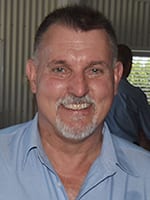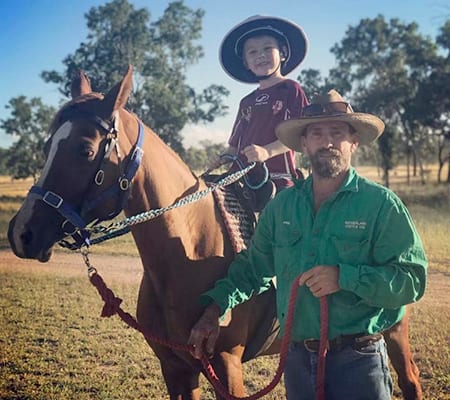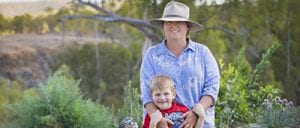If you don’t test, it’s just a guess – landholders turn to science to improve
Diagnostic tests from plant tissue, soil and and water is helping landholders of the Normanby Cluster Group to improve nutrition, pasture usage, herd performance and productivity.
This cluster group of five properties was formed off the back of a ‘catchment catch up’ held at Sutherland Station in October last year.

Jim Wade
The LDC project has enlisted the expertise of agriculture consultant and qualified nutritionist Jim Wade of Wade Agriculture Consultants to work with the group to determine how best to provide cattle with a balanced diet all year round.
Diagnostic tests of plant tissue, soil and water from each property, is helping graziers understand the science behind how best to provide their herd a balanced diet to optimise feed efficiency, weight gain and production outcomes.
Dry pastures can leave graziers with low protein, stubble and roughage to get stock through summer, so supplementation plays a vital role.
Jim is guiding landholders on balancing how much grazing occurs and how much time is allowed for recovery of the grazed pastures, and knowing what feed additives to provide livestock, including custom supplement mixes for optimum performance dependent on the season.
Healthy animals fed balanced diets and provided with good supplies of fresh water will be the most productive. These animals will be the most profitable to the landholder and the most efficient users of nutrients.
This is why the cluster group is also addressing fencing and water infrastructure. This includes determining farm water requirements, and water quality, as well as the distribution, water storage and pumping options.
Jim is also helping graziers to balance breeder numbers to increase production, and pasture management practice, and how to care for the landscape to reinvigorate the nutrient cycle, build species diversity and increase ground cover plant density to make sure herds benefit by gaining and holding weight during dry times.
Department of Agriculture and Fisheries’ beef extension officer Jim Fletcher is also providing extension help and carrying out the soil sampling on each property.
Zamia staggers in cattle
All properties in the Normanby cluster group have zamia palms in grazing paddocks.
Jim Wade is formulating a detox lick or block to be trialled on one or more of the properties.
Using a bioavailable form, such as zinc, can help with epithelial tissue repair of the gut. It is hoped that binding the toxin in the rumen before it is absorbed, while delivering nutrients that help repair damaged tissues, will minimise the effects of zamia.
Grazing cattle in zamia-infested country can become costly for graziers due to annual losses from poisoning.
Cattle get the staggers when they eat the fresh fronds because the fronds contain a neurotoxin that affects the nervous system in the spinal column affecting the back legs of cattle.
Cattle that develop neurological signs do not improve. The rickety condition of affected cattle makes them difficult to market, as they are likely to fall down in transit and cause other sound stock to go down and become injured.
As the condition is nervous, the quality of the meat is not affected.
One control method for landholders is to fence off the zamia country and only graze it for short periods when young shoots and seeds are not evident, and supplementary feed is available.
Chemical control of cycads is difficult. Reshooting from the base of the plant will occur if treatment is not thorough. The use of Tordon 75D injected into the stem is effective and is registered for this use. However, chemical control of zamia is usually uneconomic because it grows in lower carrying capacity country.
There are legal requirements for the conservation of cycads. Landholders must have up-to-date and accurate advice from the Department of Agriculture and Fisheries if they want to treat zamia.
Peer to peer learning
AN important component of LDC is to foster peer groups in the BBB catchment that are self-directed, and are supported by extension staff, to help deliver skills and knowledge.
In a peer group everything gets shared — what works, what doesn’t and why. Trust is key.
Four cluster groups have been formed – two groups focused on erosion control activities, and two groups focused on grazing land management activities.
This is a great example of how the BBB Grazier Support and Landscape Remediation Activity Areas are working together to achieve productive outcomes for graziers.
For further information on the LDC project’s Activity Areas, click here.
Graziers interested in joining a cluster group can contact an LDC grazing team member.
Mustering at Sutherland Station.
Attending a Community Catchment Catch Up at Sutherland Station, from left, Brett Stagg, Normanby Station, Tom Murphy, Tabletop Station and LDC project panel member, Brett Scott, Flagstone Station, at back, Rodger Walker, NQ Dry Tropics’ LDC team member, and Daryl Young, Shannonvale Station.
Jo Travers and Paul Thorogood and their son Cooper – owners of Sutherland Station

Paul Thorogood with son Cooper at Sutherland Station

Jo and Cooper Travers
“Paul and I have found the cluster project invaluable. Since moving to the area last March (2018) from Central Queensland, we have been on a crash course on cattle nutrition for the North.
Finding the right supplement has taken a considerable amount of trial and error. Jim Wade’s extraordinary wealth of knowledge and ability to simplify and translate, has given us a stronger and clearer understanding of what our country’s nutritional composition is and the dietary needs of our stock.
This has given us the confidence to move forward implementing holistic planned grazing.”
— Jo Travers


